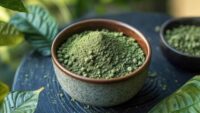Kratom for pain management has gained significant attention in recent years as individuals seek alternative methods to alleviate chronic pain. Traditional pain management options often come with side effects or risks of dependency, leading many to explore natural remedies like kratom. Kratom, a plant native to Southeast Asia, has been used for centuries in traditional medicine for its analgesic and energizing properties. Its primary alkaloids, mitragynine and 7-hydroxymitragynine, play crucial roles in its pain-relieving effects.
Introduction to Kratom and Pain Management
Kratom, scientifically known as Mitragyna speciosa, is a tropical evergreen tree that has been a part of traditional medicine in countries like Thailand and Indonesia for centuries. It is known for its leaves, which contain a variety of bioactive compounds, primarily alkaloids. These alkaloids are responsible for kratom’s effects on the body, including pain relief and mood enhancement. As the world grapples with the challenges of chronic pain, kratom has emerged as a potential alternative to conventional pain management strategies.
Kratom Alkaloids: Mitragynine and 7-Hydroxymitragynine
The two most significant alkaloids in kratom are mitragynine and 7-hydroxymitragynine. Mitragynine is the most abundant alkaloid and is responsible for many of kratom’s effects, including its energizing and analgesic properties. However, it is 7-hydroxymitragynine that is particularly noted for its potent pain-relieving effects. This alkaloid is a metabolite of mitragynine and is known for its strong interaction with opioid receptors in the brain, which are key to pain perception.
The interaction between these alkaloids and opioid receptors is complex. While they do not cause the same level of dependency as traditional opioids, they can provide significant pain relief by activating these receptors. This mechanism of action is what makes kratom an attractive option for those seeking to manage chronic pain without the risks associated with opioid medications.
Mechanism of Action: How Kratom Relieves Pain?
Kratom’s pain-relieving effects are primarily due to its interaction with the body’s opioid receptors. These receptors are part of the endogenous opioid system, which regulates pain perception. When mitragynine and 7-hydroxymitragynine bind to these receptors, they can produce analgesia, or pain relief. Unlike traditional opioids, however, kratom alkaloids tend to have a more nuanced effect, often described as stimulating at lower doses and sedating at higher doses.
The synergistic effect of these alkaloids is crucial for kratom’s overall efficacy in pain management. While mitragynine provides a broader range of effects, including energy and mood enhancement, 7-hydroxymitragynine is more potent in terms of analgesia. This combination allows kratom to offer a balanced approach to managing pain, potentially reducing the need for pharmaceutical painkillers.
Efficacy of Kratom for Pain Relief
Numerous studies and user reports suggest that kratom is effective in providing pain relief. Many individuals with chronic pain conditions have turned to kratom as a natural alternative to manage their symptoms. The efficacy of kratom can be attributed to its ability to interact with opioid receptors without causing the same level of dependency as traditional opioids.
However, while user experiences are overwhelmingly positive, there is a need for more rigorous scientific research to fully understand kratom’s effects and potential risks. Current studies are limited, and more data is required to establish kratom as a reliable option for pain management.
Safety and Potential Risks
While kratom is generally considered safe when used responsibly, there are potential risks and side effects to be aware of. Common side effects include nausea, dizziness, and headaches. More serious risks, such as dependency and withdrawal symptoms, can occur with prolonged use or high doses. It is essential for users to be mindful of these risks and to consult healthcare professionals before incorporating kratom into their pain management regimen.
The mitragynine pseudoindoxyl aspect, related to the chemical properties of mitragynine, highlights the complexity of kratom’s alkaloid profile. Understanding these chemical properties can provide insights into how kratom interacts with the body, though more research is needed in this area.
Conclusion
Kratom, particularly through its alkaloids mitragynine and 7-hydroxymitragynine, offers a promising alternative for pain management. Its natural origin and potential for fewer side effects compared to traditional opioids make it an attractive option for those seeking relief from chronic pain. However, it is crucial that users approach kratom with caution and consult medical professionals before use. Further research is necessary to fully understand kratom’s benefits and risks, ensuring its safe and effective use in managing pain.
Kratom’s role in pain management is significant, and its potential as a natural remedy for chronic pain is undeniable. As research continues to uncover more about kratom’s effects, it may become a valuable tool in the fight against pain, offering hope to those who have struggled with traditional treatments.
More Readings:






















